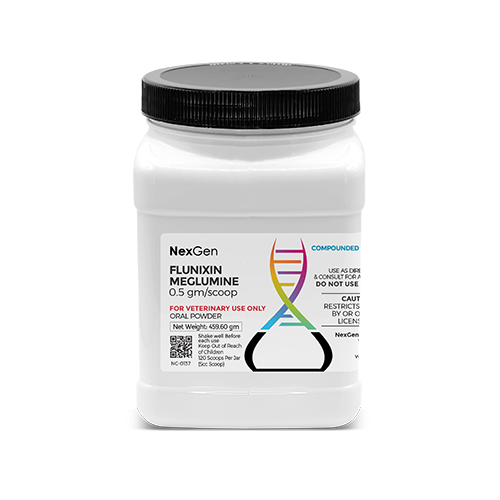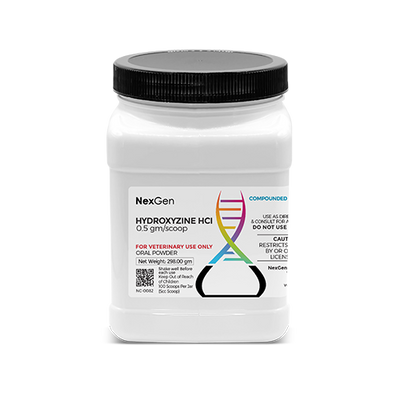
Flunixin Meglumine 500 mg/scoop, Oral Powder, 120 Scoops (5cc Scoop)
Login for pricing
- Brand
- Mixlab
- SKU:
- NC-0137
- Product Type:
- Powder
- Size:
- 32oz
- Administration:
- Oral
- Scoops Per Container:
- 120
- Scoop Size:
- 5cc
In horses, healthy joints provide a frictionless system that allows ease of movement. Joints depend on the function of each of its components to serve this purpose in performance horses. Bone, articular cartilage, synovial fluid, synovial membranes, fibrous joint capsules, and ligamentous structures constitute these components.1
Even slight injuries in the horse can give rise to inflammation, and swelling is one of the most prevalent signs of inflammation, along with heat and pain. Observation of a horse at work followed by palpation of limbs post exercise/cool-down is vital to the early detection of swelling.2 By identifying signs of inflammation early, steps can be taken to reduce it and thereby potentially reduce the severity of work-related injuries.
Soft Tissue Injuries in Horses
Soft tissue injuries are fairly common in horses, particularly racing Thoroughbreds. These horses frequently require prolonged periods of rest before being raced again, and the earlier a soft tissue injury is identified, the earlier a diagnosis can be reached and the quicker a horse can get back into training.
In the event of palpating swelling, or discovering heat or pain along a horse’s limb, it is essential that exercise be stopped. At this juncture, cold therapy with pain relief (preferably, nonsteroidal anti inflammatory drug) are typically recommended. Cold hosing can also be effective, but can be impractical during the summer months.2 If possible, cold therapy should continue at a tapering frequency for an additional two to three days. If the swelling is still present or there is heat or pain on palpation at this time, then an ultrasound examination of the area is indicated. This is because continuing to exercise a horse with a mild tendon strain, for example, poses a risk for more severe injury.1
Flunixin: Indications for Equines
Flunixin meglumine is a nonsteroidal anti-inflammatory drug (NSAID) and cyclooxygenase inhibitor. It is used as a potent pain reliever, fever reducer, and anti-inflammatory in horses. A common use of flunixin in horses includes pain relief in the treatment of colic.
Also labeled under the name Banamine®, this veterinary-only NSAID is used primarily in large animal species. In the United States, flunixin is FDA-approved for use in horses, cattle, and swine; it is approved for use in dogs in other countries. Transdermal flunixin formulations are FDA-approved to control pyrexia associated with bovine respiratory disease (BRD) and control of pain associated with foot rot in steers, beef heifers, beef cows, beef bulls intended for slaughter, and replacement dairy heifers under 20 months of age. In swine, flunixin is FDA-approved for controlling pyrexia associated with swine respiratory disease. In ruminants, there is anecdotal evidence that flunixin is a better analgesic for visceral pain rather than for musculoskeletal pain.3
Plumb’s Veterinary Drugs indicates that flunixin has also been suggested for many other indications in horses including foal diarrhea, shock, colitis, respiratory disease, postrace treatment, and pre- and postophthalmic and general surgery. Flunixin is a potent inhibitor of cyclooxygenase and, like other NSAIDs, it exhibits analgesic, anti-inflammatory, and antipyretic activity. Flunixin does not appreciably alter GI motility in horses and may improve hemodynamics in animals with septic shock.3
It is recommended that flunixin be used with caution in patients with pre-existing GI ulcers or renal, hepatic, or hematologic diseases; in horses with colic, flunixin may mask the behavior and cardiopulmonary signs associated with endotoxemia or intestinal devitalization. If the first dose is ineffective for pain control, subsequent doses are unlikely to be of benefit. Adverse effects in horses and cattle include anaphylaxis (rarely, after rapid IV administration); IM injections (extra-label in food animals) may cause pain and swelling. Myonecrosis has been reported in some horses.3
Flunixin Dosages for Horses
Flunixin dosing for horses is as follows (adapted from Plumb’s Veterinary Drugs):
Alleviation of inflammation and pain associated with musculoskeletal disorders and alleviation of visceral pain associated with colic (Label dosage; FDA-approved):
-
Injectable: 1.1 mg/kg IV or IM once daily for up to 5 days. For colic cases, use IV route; may re-dose when necessary.
-
Oral Paste: 1.1 mg/kg PO (see markings on syringe—calibrated in 250 lb weight increments) once daily.
-
Decreasing pain, inflammation, and edema in laminitis (extra-label): 0.5 – 1.1 mg/kg IV or PO every 8 to 12 hours. A dose of 0.25 mg/kg can be administered IV every 8 hours to interrupt eicosanoid production associated with endotoxemia.
-
Adjunctive treatment of uveitis in foals (extra-label): 0.5 – 1 mg/kg (route not noted) twice daily.
Where to buy Flunixin
Flunixin is available in the U.S. through several pharmaceutical manufacturers and through veterinary custom compounding companies. FLUNIXIN 500 MG/SCOOP by NexGen Pharmaceuticals is rapidly absorbed following oral administration and an excellent solution for the inhibition of biochemicals that stimulate the inflammatory response in horses.
FOR RX ONLY: A valid prescription from a licensed veterinarian is required for dispensing this medication.
1Long, Alicia, and Rose Nolen-Walston. Equine Inflammatory Markers in the Twenty-First Century: A Focus on Serum Amyloid A. The Veterinary clinics of North America. Equine practice vol. 36,1 (2020): 147-160. doi:10.1016/j.cveq.2019.12.005
2Knych HK, Arthur RM, McKemie DS, Baden RW, Seminoff K, Kass PH. Pharmacokinetics and anti-inflammatory effects of flunixin meglumine as a sole agent and in combination with phenylbutazone in exercised Thoroughbred horses. Equine veterinary journal. 2020.
3Plumb’s Veterinary Drugs.
















